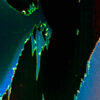We planned the funeral for the twentieth of April because it was a Saturday, when the largest number of people could make it. My aunt wrote to me that Mama’s spot at the cemetery had been booked, and the men in the family watched a YouTube video about burying an urn containing ashes. It turned out that an urn didn’t require a deep, two-metre hole, like a body did. A shallow niche in the earth would suffice. It was still winter in Ust-Ilimsk, and the men went to the cemetery to gouge the frozen ground with shovels and picks.
Having sent the last message, I shut the laptop, and it suddenly dawned on me that I would have to say goodbye to Mama’s ashes. We had lived together for about two months, and the urn had become part of my household and interior landscape. I often addressed it with looks and words. I talked to it. I stroked it with my hand, and sometimes I opened it, to be nearer to the capsule and to look at the dusting of ashes that covered it. At the bottom of the urn still lay a scrap of paper with our surname and her initials. I couldn’t bring myself to throw it out. It was also covered in a thin sprinkling of ashes, it was part of this heavy object.
I packed for a long trip: several pairs of socks, items of underwear, (a few of which I’d bought in Volzhsky after the farewell to Mama), jeans, T-shirts, and a pair of linen trousers and a shirt. I had completely forgotten what April in Siberia is like. In Moscow, the sun shone warmly and there hadn’t been snow on the ground all winter; at night the snowploughs cleaned it up thoroughly and in the morning the migrant cleaners did. By April I was going around in a thin wool coat and light trousers with no tights underneath. For some reason I thought that Siberia would be similarly warm and snowless. Into the carrot-coloured bag, alongside my clothes, I put the box with Mama’s urn. I got dressed, sat down before the trip, and said: alright, Mama, we’re going to Siberia. I felt like crying. I was travelling to bury my mother and bringing her with me. I felt like crying because of the uncertainty. Following some long, unpleasant conversations with the landlord’s family I had found a new flat through Facebook, and I knew that this was my last day of being here, in this lived-in, comfortable, familiar spot. My mother had died and I had become an orphan, and now I didn’t even have a place of my own. There was nowhere for me to come back to.
In the metro, without taking off the rucksack, I sat down on a bench and waited for the train. The corner of the urn case dug into my back, but I endured it. I was thinking that I needed the pain and discomfort, because I was on an important ritual journey, which is always marked by suffering.
I already knew that Aeroflot transported urns containing human ashes in the cargo hold, along with oversized cargo. At the airport, I went up to the check-in counter and handed over my passport. Without even looking at me, the woman began to search for my information in the database. I had to tell her about my luggage, and, clearing my throat, I said that I was travelling with ashes. The woman still didn’t look at me. I repeated my statement and started opening my blue plastic folder with sweating hands. I told her I could show her all the necessary documents. She finally looked at me, said that she didn’t need to see any documents, and handed me a tag for oversize luggage. She ordered me to put the bag in the hoist and to come back to her.
I went in horror to the iron hoist. I had to leave Mama unattended. In the hoist stood a covered bulky mountain bike and an enormous animal carrier. There was no movement in the carrier. I knew that animals get sedated for flights, so they’ll sleep, and I felt unbearably sorry for this large invisible dog. It was sleeping and it didn’t know that it would travel in the cold cargo hold. What if it woke ahead of schedule? The noise, the cold, closeness, darkness – that’s what the dog will see, I thought, and it’ll bark in helplessness and desperation. But no-one will hear. Will the dog survive the flight? Yet I was calmed, a little, by the thought that Mama wouldn’t fly alone, but with a whole sleeping dog. I lowered the carrot-coloured bag to the floor behind the carrier and whispered into the emptiness that everything would be fine and we would see each other again soon.
I was surprised by the airline worker’s credulity. After my experience in Volgograd, where Mama and I, along with our documents, had been palpated and practically cross-examined, I expected that in Moscow I would be thoroughly interrogated. After all, I could have been carrying explosives, drugs, you name it. Though the certificate of non-inclusion from the Volgograd crematorium looked fake, it did have an official stamp and a signature. It confirmed that the urn contained no alien substances or objects. How strange, I thought, that drug dealers and terrorists haven’t used this method to transport things. Though maybe they do use it, and I just don’t know.
Annie Leibovitz photographs the sick, and then the dead, body of Susan Sontag, and then she painstakingly captures the death of her own father. Ron Mueck makes a silicone sculpture of his father’s dead body and adds hair to it that is neither artificial nor someone else’s, but his own. Daphne Todd paints a portrait of her dead mother.
The picture of Sontag dead is repulsively confined; it’s a narrow, horizontal photograph, its composition similar to Holbein’s dead Christ. There’s no room to breathe. It’s dark and constricts the gaze on every side. It’s insufficient, uncomfortable. This is also because the format forces us to look beyond the borders of the photograph. Everything around serves to distract from the terrible event: death. It’s impossible to see a beloved body dead and preserve it in your memory. To connect with it. The world will always tremble and live on, distracting you from the most important thing – the dark rectangle of loss. Mueck creates an object, and in order to fix our attention on the fragility of the dead body he doesn’t clothe the sculpture. His father lies naked and dead, reduced to two thirds of his actual size. Mueck feared his father, who always seemed to him to be a severe and inflexible person; his death provided the possibility of taming him. Of making his father his, of no longer fearing him. But all that aside, working with a dead body always implies shifts in scale. We only need to adjust the size of an object to demonstrate the power we wield over it. We have the ability to control both body and memory, because we are living.
Todd’s work, though it’s extremely realistic, is painted in light shades. There’s no place in it for the colour black. Even her mother’s dropped jaw bares not the black hole of unbeing, but a light brown space. The old woman’s whitish eyes are open, and everyone can see the light, thin, sunken breast. This is death in old age and in prosperity. But here, too, we see a diminishment of scale: in a photo on the internet I can see Todd herself in front of her painting. The old woman’s head is half the size of the living daughter’s head. The dead hands are elongated by the perspective. Like dry branches they’ve fallen onto the white sheet. The depiction of Daphne Todd’s mother’s death is an emblem of ideal death. In deep, fortunate old age, when all control, including control over the treatment of the image of your dead body, is ceded to your loved ones.
Why did they do this? Why am I doing this – steadily describing the dying and the dead body of my own mother? There’s a lot of pain in this, along with an attempt to understand, to write out an experience. But there’s also a note of vanity: to go on living is to retain control over your own body. And over the bodies of your departed loved ones. I’m finally taking for myself that which belonged to me, but wasn’t available to me until after her death – her body. And I’m displaying it for everyone to see, like a trophy. Like a wound sustained in a long, difficult war. I have the right.
Leibovitz photographs her sleeping (or dead?) father. She photographs him as though she were looking at him very closely. Her father’s face is calm. His head lies on a floral patterned pillow. On his cheeks there are the dark spots of old age; he’s all dried up, like a sun-bleached branch, and very small, like all dead people. The photograph is open to viewers. It doesn’t hurt me to look at it, and I don’t feel constrained, though I know that death drowses there. Then I look at another photograph – in a large, well-lit room, its walls hung with photos and landscapes, stands a large hospital bed. It’s like a heavy block of marble, glowing. The bed is empty. Behind it, in an armchair, someone sits covering their face with a hand, crying, or just thinking about something. The photograph is called My Parents’ Living Room. In a third photograph there’s a rectangular hole framed with broad wooden boards. And next to the hole, a mound of damp earth and dry earth, mixed together.
These three photographs are part of the larger A Photographer’s Life series. Leibovitz took pictures of her elderly parents, her sisters, and other people close to her. And also of death and its markers. They’re very peaceful photographs. If you were to imagine a sound issuing from them, it would be a muted radio transmission and the ringing of a small spoon against a plate, drowning in white noise. Life is happening there.
I flew knowing that somewhere in the cargo hold a dog was sleeping, and next to it lay the bag that held Mama’s urn. Had the cargo workers been sufficiently careful with the bag? What if they’d thrown it into a pile of other luggage? What if Mama’s urn had been dented? Or what if the change in pressure made the soldered tin lid with the cremation serial number pop off? The whole compartment would be covered in Mama’s ashes. What was I supposed to do then? What would the people who work for Aeroflot do then?
Some things can be renewed or returned, but some things are unique. There’s no other urn of Mama’s ashes anywhere, and what’s worse is there’s no other Mama, and this urn is the final trace and remainder of her. What would happen if I lost even that? Half a year later, due to the carelessness of Aeroflot workers, some cats would perish in a cargo hold. They were simply crushed by the rest of the luggage. How did the owners of those animals feel?
I flew staring in front of me. I imagined the dog waking up because something was tickling its nose, and that something was Mama’s ashes. The dog would sneeze. Instantaneously, all the other objects in the cargo hold – the mountain bike, the double bass, everything else – would be covered in fi ne grey-white dust, all that was left of the body of my mother. My jaw began to hurt, and I caught myself grinding my teeth. I was tense with fear.
The night flight from Moscow to Novosibirsk ends in your landing, completely wrecked, at dawn. It was about five in the morning in Novosibirsk and getting light; my head hurt and I wanted to sleep. I got off the plane quickly and ran to the baggage carousel. One after the other, bags appeared on the carousel – a black sports bag, a huge fabric suitcase, a little suitcase with a pink pony and a rainbow, a chequered Chinese bag . . . I wasn’t sure where the oversize luggage would be returned. I felt suffocated by panic, I frantically scanned the hall, I couldn’t spot a single person who worked for the airport. Twenty minutes in, the grey animal carrier showed up, jostling now and then as it travelled around the carousel. The dog inside was still asleep. Or it was already dead, because its heart had burst after all that barking and panic. A man came up to the carousel, caught the carrier by its handle, and yanked it off. He opened the carrier and took out a tiny bichon. For a second I forgot about Mama. She hadn’t been accompanied by a majestic beast with a huge body and steady breath, but by a quiet, nervous, cream-coloured bichon. The little dog went on sleeping. The man passed it to the woman who was with him, quickly took the carrier apart, and taped its parts together.
Finally the carrot-coloured rucksack appeared on the carousel. The bag had been overturned in transit; it was trailing the sleeve of my green linen shirt. This meant that it had been shaken, thrown, its zipper had popped open. I grabbed the bag and with my shaking hands unzipped it the rest of the way. Everything inside was turned upside down – my underwear, socks, and jeans lay mixed up with toothpaste and books, and the box with Mama’s ashes was open. I felt cold and pained. I reached out my hand and lifted open the lid of the box. The urn lay in its place, it had been saved by the fact that the box was large and I’d stuffed my clothes around the urn so it wouldn’t roll around and knock against the wood. But I saw a small dent in its lid. I lifted it. Inside the urn lay a capsule wrapped in a small cotton sack; I had foreseen turbulence and careless handling, so I’d swaddled the capsule in a bag. Everything was in its right place. The capsule hadn’t opened or cracked, it hadn’t burst. It lay quietly inside the urn.
Image © Michael Coghlan

This is an extract from Wound by Oksana Vasyakina, forthcoming in an English translation by Elina Alter from MacLehose and Catapult.








